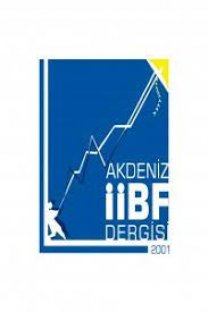Is a correction necessary for beta estimation?
Beta tahmini için düzeltme gerekli mi?
___
- ALEXANDER, G.J.and BENSON, P.G. (1982) More on Beta as a Random Coefficient, Journal of Financial and Quantitative Analysis, 17, 27-36.
- ALTMAN, E. I.., JACQUILLAT, B. and LEVASSEUR, M. (1974) Comparative Analysis of Risk Measures: France and the United States, Journal of Finance, 29, 1495-1511.
- AVRAMOV, D. and CHORDIA T. (2006) Asset Pricing Models and Financial Market Anomalies, The Review of Financial Studies v 19 n 3, 1001-1040.
- BAESEL, J.B. (1974) On the Assessment of Risk: Some Further Considerations, Journal of Finance, 29, 1491-1494.
- BEER, F. M. (1997) Estimation of Risk on The Brussels Stock Exchange: Methodological Issues and Empirical Results, Global Finance Journal, 8 (1), 83-94.
- BLUME, M. E. (1971) On the Assessment of Risk, The Journal of Finance, 26, 1-10.
- BLUME, M. E. (1975) Betas and Their Regression Tendencies, The Journal of Finance, 30, 785-795.
- BOS T. and NEWBOLD, P. (1984) An Empirical Investigation of the Possibility of Stochastic Systematic Risk in the Market Model, Journal of Business, 57, 35-41.
- BRAILSFORD, T.J. and FAFF., R.W. (1997) Testing the conditional CAPM and the effect of intervaling: a note, Pacific-Basin Finance Journal, 5, 527–537.
- BRAILSFORD, T. J. and JOSEV, T. (1997) The impact of return interval on the estimation of systematic risk, Pacific-Basin Finance Journal, 5, 357- 376.
- BRAUN, P., NELSON, D. and SUNIER, A. (1995) Good news, bad news, volatility and betas, Journal of Finance, 50, 1575–1603.
- CHENG, J. and BOASSON, V. W. (2004) Using the Time Weighted Method to Estimate Betas of Emerging Markets, Managerial Finance, v 30 n 3, 74-87.
- CLARFELD, R. A. and BERNSTEIN, P. (1997) How to interpret measures of risk—Understanding Risk in Mutual Fund Selection, Journal of Accountancy, July, 45-49.
- COHEN, K.J. HAWAWINI, G.A., MAIER, S.F., SCHWARTZ, R.A., & WHITCOMB, D.K. (1980) Implications of microstructure theory for empirical research on stock price behavior, Journal of Finance, 35, 249-257.
- COHEN, K., HAWAWINI, G., MAYER, S., SCHWARTZ, R., and WHITCOMB, D. (1983) Estimating and Adjusting for the Undervaluing Effect Bias in Beta, Management Science, 29, 135-148.
- COLLINS, D.W., LEDOLTER, J., and RAYBURN, J. (1987) Some Further Evidence on the Stochastic Properties of Systematic Risk, Journal of Business, 60, 425-448.
- DIMSON, E. (1979) Risk measurement when shares are subject to infrequent trading, Journal of Financial Economics, 7, 197-226.
- ESTRADA, J. (2000) The Temporal dimension of risk, The Quarterly Review of Economics and Finance, 40, 189-204.
- FABOZZI, F. J. and FRANCIS, J. C. (1978) Beta as a Random Coefficient, Journal of Financial and Quantitative Analysts, March, 101-116.
- FABOZZI, F. J. (1999) Investment Management, Second Ed. Prentice-Hall, Inc. NJ.
- FRANKFURTER, G., LEUNG, W. and BROCKMAN, P. (1994) Compounding Period Length and the Market Model, Journal of Economics and Business, 46, 179-93.
- GROENEWOLD, N. and FRASER, P. (1999) Time-varying estimates of CAPM betas, Mathematics and Computers in Simulation, 48, 531-539.
- HANDA, P., KOTHARI, S.P. and WASLEY, C. (1989) The relation between the return interval and betas: implications for the size effect, Journal of Financial Economics, 23, 79-100.
- HANDA, P., KOTHARI, S.P. and WASLEY, C. (1993) Sensitivity of multivariate tests of the capital asset pricing to the return interval measurement, Journal of Finance, 48, 15–43.
- HARVEY, C.R. (1989) Time-varying conditional covariances in tests of asset pricing models, Journal of Financial Economics, 24, 289–317.
- HAWAWINI, G. (1983) Why beta shifts as the return interval changes, Financial Analysts Journal, 39, 73–77.
- KARACABEY, A. A. (2001) Beta and Returns: Istanbul Stock Exchange Evidence, Social Science Research Network, Working Paper, June 16.
- LEE, C.F. and CHEN, C.R. (1982) Beta Stability and Tendency: An Application of a Variable Mean Response Regression Model, Journal of Economics and Business, 34, 210— 216.
- LEE, J.-S. and JANG, S. (2007) The systematic-risk determinants of the US airline industry, Tourism Management, 28, 434-442.
- LEVHARI, D. and LEVY, H. (1977) The capital asset pricing model and the investment horizon, Review of Economics and Statistics, 59, 92–104.
- LEVY, R. A. (1971) On the Short-Term Stationarity of Beta Coefficients, Financial Analysts Journal, 27, 55-62.
- LINTNER, J. (1965) The Valuation of Risky Assets and the Selection of Risky Investments on Stock Portfolios and Capital Budgets, Review of Economics and Statistics, 47, 13-37.
- MARKOWITZ, H. M. (1952) Portfolio Selection, Journal of Finance, 7, 77-91.
- MAXIMILIANO G. F. (2001) CAPM performance in the Caracas Stock Exchange from 1992 to 1998, International Review of Financial Analysis, 10, 333-341.
- OHLSON, J. and ROSENBERG, B. (1982) Systematic Risk of the CRSP Equal-Weighted Common Stock Index: A History Estimated by Stochastic Parameter Regression, Journal of Business, 55, 121-145.
- ROENFELDT, R. (1978) Further Evidence on the Stationarity of Beta Coefficients, Journal of Financial and Quantitative Analysis, March, 11-21.
- SCHOLES, M. and WILLIAMS, J. (1977) Estimating betas for nonsynchronous trading, Journal of Financial Economics, 5, 309-327.
- SHARPE, W. (1964) Capital asset prices: a theory of market equilibrium under conditions of risk, Journal of Finance, 19, 425–442.
- SUNDER, S. (1980) Stationarity of Market Risks: Random Coefficient Tests for Individual Stock, Journal of Finance, 35, 883-896.
- VASICEK, O. (1973) A Note on Using Cross-Sectional Information in Bayesian Estimation of Security Betas, Journal of Finance, 28, 1233-1239.
- ISSN: 1302-9975
- Yayın Aralığı: Yılda 2 Sayı
- Başlangıç: 2001
- Yayıncı: Akdeniz Üniversitesi
Is a correction necessary for beta estimation?
Türkiye'deki emeklilik fonlarının performans ölçümü ve fon yöneticilerinin zamanlama yeteneği
Turhan KORKMAZ, Hasan UYGURTÜRK
Türkiye'nin tüketim fonksiyonu: Parçalı hata düzeltme modeli bulguları
Gülçin Güreşçi PEHLİVAN, Utku UTKULU
Risk altında zamanlararası tercihler: Alternatif bir fayda fonksiyonu
Türkiye ekonomisinde iş çevrimlerinin tarih ve süre aralıklarının tespiti
Politik davranış boyutları: Bir ölçek geliştirme çalışması
Türkiye'de iller arası gelir eşitsizliğinde teşvik politikasının rolü: Bir araştırma analizi
